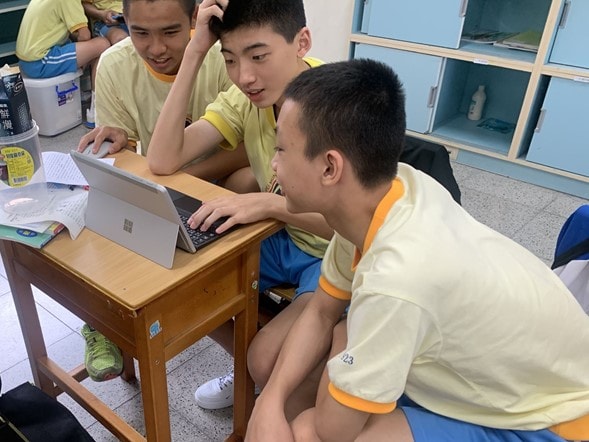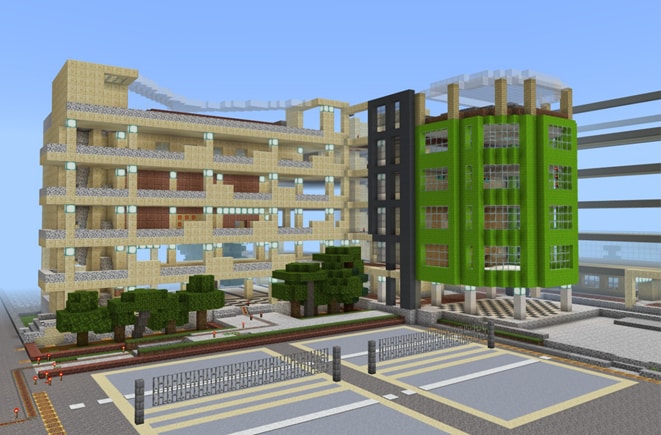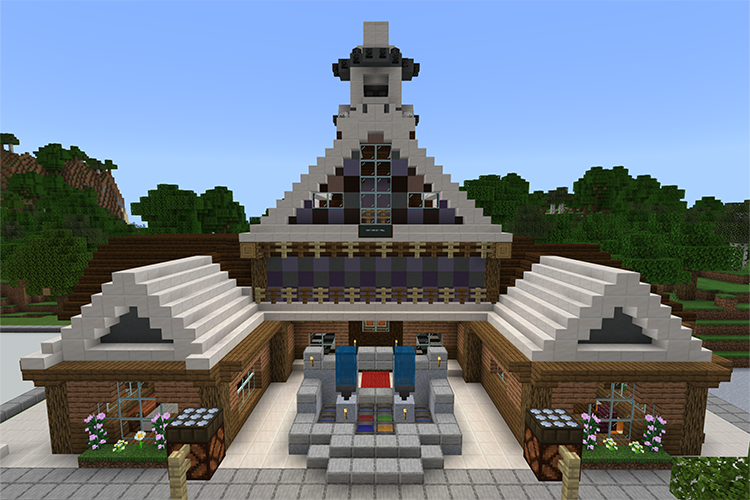Let’s go: Hai-Shan Junior High School and Minecraft in Taiwan
12 Nov 2021

12 Nov 2021

A traditionalist school system, an extensive new curriculum, and a global pandemic: Chia-man Lee from the Municipal Hai-Shan Junior High School in New Taipei City met these challenges head-on with Minecraft: Education Edition. Read her story on expanding methods of teaching, the adaptability of Minecraft as a learning platform, and the impact of engaging students through new technologies within her school community.
In my country, most schools are extremely traditional, academic-centric, and restrictive. Many educators only consider incorporating limited technology into their classrooms. As the former student activities section chief at my home school, I would often conduct integrative activities outdoors, organizing various exercises connected with areas of the curriculum. As the number of students grew, however, it became a challenge to ensure the safety of individuals on an open field. The worldwide pandemic only amplified these concerns.
Hai-Shan Jr. High School encourages teachers to exercise freedom in developing their unique teaching materials. Responding to our 108 National Curricula, I’ve strongly prioritized digitalization. Considering the students’ transformed learning environments, and the need to conform to safety measures, I wanted something that could be adapted to indoor education while still captivating students’ attention and stimulating engagement. I decided to use Minecraft: Education Edition as my teaching platform. The more I investigated our original courses, the more I realized how compatible Minecraft could be with our program.
The game has the capacity to facilitate map learning, problem solving, environmental awareness, orientation, and architectural graphic concepts. I’ve also found that Minecraft is extraordinarily adaptable and that lessons are easy to conduct. Each teacher is responsible for multiple classes, so we not only need to design interactive courses, but we also must adapt relevant materials to each individual class. With Minecraft, this design process becomes far less tedious.
One event confirmed how well-known Minecraft was among our students of all grade levels. Every semester, we host a book fair where learners can showcase their prized possessions. Without arranging it beforehand, five or six different students from each of our classes brought the same series of Minecraft books to school! It turned out that many had been avid players since their elementary years. They were all extremely excited to discuss the concepts they learned and the hardships they overcame in the game.

We then invited these students as group representatives to discuss the structural components and blueprints of the school itself. Their enthusiasm and eagerness to participate was outstanding! With teachers providing the rough architecture of the school and students fleshing out the details, seven classes collaborated to re-create our campus and buildings.
We selected one class to become the catalyst for fully incorporating Minecraft into our school program. For 20 weeks, this group conducted various tests on the makeshift virtual school grounds to aid teachers in adjusting their content and to help us better understand the amount of time required to design and run activities. This gave students the chance to showcase their abilities and take further ownership over their learning.
After those initial 20 weeks, five classes—each working on different activities aimed at progressing our Minecraft teaching capacity—helped us attain our current state of game-based learning. We’re now conducting a multi-year, collaborative, cross-curricular project that takes place in the virtual school. The platform motivates students to participate and learn in class. Many who are often overlooked get the chance to show off their talent for interpretation and creativity. Personally, I like to design theme-centric courses that last around a month before I change the theme again. Using Minecraft to combine classes from different grade levels, I conduct rotational activities that develop familiarity with how our system works.

We allocate each device to a group of 2-3 students. Our teachers assign the most playful student to be the instructor, and they guide their peers toward inclusive interaction and expressive skills. That allows us to merge students of various grade levels and subjects, making classes more interesting.
Here’s how our project progression comes together in the virtual campus:
Around 200-300 students have learned through Minecraft in my classroom. Ever since the introduction of the game, the amount of laughter and unity has skyrocketed! Learners are highly engaged. They constantly practice cooperation and communication, which aids in their development of self-expression (aiding in social-emotional learning). More proficient students will often assist those with less Minecraft knowledge. And most importantly, this method has helped introverted students open up more through the common ground the platform provides. This accessibility provides many learners with a new sense of value and contribution.
Since this platform provides pathways to a whole new realm of knowledge around technological advancement, the school has become more inclusive for students who are heavily interested in extra-curricular activities. By the time they graduate from junior high school, learners have obtained the ability to navigate NPC settings, build using MakeCode, and design a device by using Redstone.

I can now monitor everyone’s progress and tend to their needs efficiently. On the other hand, students gain the opportunity to manage their time at a comfortable pace, learning to be independent and keeping a schedule on their own. With recorded tutorial videos, learners now have access to explanations of assignments at any time, and teachers can focus more on developing their students’ non-academic skillsets.
My plan is to teach more courses that will enhance even more skills through Minecraft. I hope to blur the line between technology, game-based learning, and teaching even further. I’m also inviting other teachers at my school to use NPCs to communicate English, information technology, and geography. As a result, students can learn vocabulary, grammar, and research skills in a way that allows them to expand their creative young minds.
Minecraft also allows learners to dream of careers they might explore. If they choose to continue playing, they might open doors to the gaming industry, software engineering, and even the possibility of becoming esports professionals!
The drastic change in setting and the ability to inhabit a fictional character allows students to explore life outside the classroom, revealing new possibilities and motivating them to learn more about their surroundings. Through Survival Mode, students are compelled to anticipate and prepare for impending danger. As groups of learners strategize to overcome obstacles as a team, they exercise their critical thinking skills and learn the importance of cooperating with others. This not only strengthens social skills but encourages individual development that will help students deal with uncertainty.
Today’s young people are expected to learn through hands-on experiments to innovate and empower the skills they’ll need in the future. The goal is that they share their thoughts and creativity through video production and other demonstrations of technological ability. With Minecraft: Education Edition, students who struggle with traditional teaching methods now have access to a new, more powerful way to collaborate and express their learning.
***
Chia-Man Lee is a Microsoft Innovative Educator Trainer teaching Integrative Activities at Hai-Shan Junior High School. She has obtained the High Distinction Award within the Ministry of Education’s teaching program and is passionate about studying innovative instructional methods.
New to Minecraft: Education Edition? Get started today!